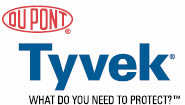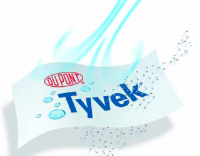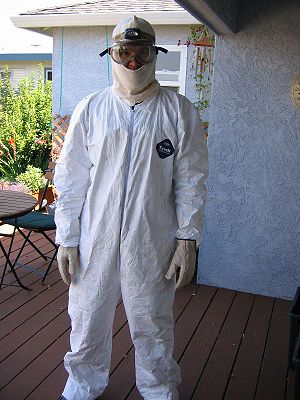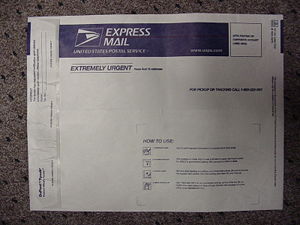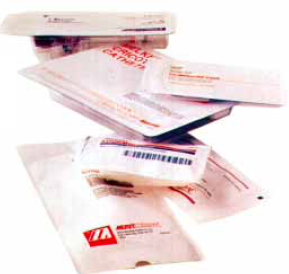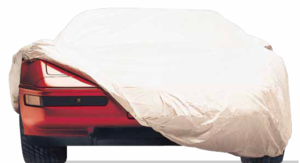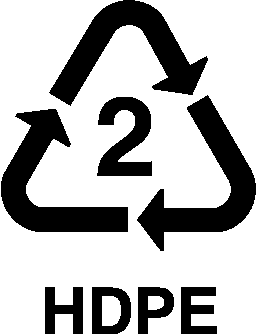Tyvek Report
From ThePlaz.com
Grade:95/100
Model not labeled
A Microsoft Word version of this work is available here: Image:Tyvek Report.doc
![]() A PDF version of this work is available here: Image:Tyvek Report.pdf
A PDF version of this work is available here: Image:Tyvek Report.pdf
Tyvek® is a brand of spunbonded olefin from DuPont. It is special because it allows water vapor to pass through it while blocking liquid water and air. Thus it allows whatever it’s protecting to "breath" but still blocks it from liquid water and air. One of its most famous applications is Tyvek® HomeWrap™ where it stops wind-driven rain and bulk water from entering houses along with stopping air flow through wall cavities, however still allowing moisture to escape from interior walls. DuPont claims that it combines the best of paper, film, and cloth. It is strong, lightweight, flexible, smooth, low-linting, and opaque. In addition it is resistant to certain chemicals, punctures, tears and abrasions.
In the absence of sunlight, Tyvek® can last for up to 20 years with a special additive. In UV light, Tyvek® requires another additive for UV resistance. Tyvek® style 1073D can withstand 2.6 N/cm of tension at room temperature. This means it is hard to tear or puncture. In addition, Tyvek® is not affected by humidity. However Tyvek® starts to loose its shape at 132°C, melts at 135°C, and burns at the auto-ignition temperature of 400°C. Thus it is not meant to be used to protect from excessive heat or flames.
Tyvek® can be flexed of 20,000 times without breaking and is half as light as paper (0.38g/cc). Mold and mildew can be grown on Tyvek® but it will not be eaten by it or introduce mold or mildew with a clean sheet. Tyvek® has a neutral pH of 7, meaning it's neither an acid nor a base. Tyvek® generates static electricity unless specially treated. It also features lower friction compared to paper. Most solvents do not affect Tyvek®, but some can cause swelling. Tyvek® to the best of anyone's knowledge is not toxic and does not require a MSDS, (material safety data sheet) however one is available covering basic safety information applicable to storing any solid.
Tyvek® comes in different types. Type 10, is a "hard," area-bonded product and is stiff and smooth. Envelopes, paper and HomeWrap™ are made of Type 10. Type 14/16 is "soft" and point-bonded with embossed patterns. This style has fabric-like flexibility, especially for use as protective clothing. Type 16 is perforated giving it greater softness and flexibility at the cost of barrier protection. Type 16 is commonly used in disposable protective garments and bags.
Tyvek® can protect many things including people, places and things. Tyvek® can be used as light-duty protection suits for hazardous environments or general, non-hazardous, industrial use. Protection is provided against water-based acids, bases, salts and splashes of certain liquids such as pesticides and herbicides. In addition protection is provided against lead dust, asbestos, and particles contaminated with radiation. The suits are light weight and disposable. Because water vapor can pass through them, the sweat can dissipate from a person's body. In addition, the low-linting properties make Tvyek® a good choice for use in "clean rooms."
Envelopes are also a common application of Tyvek®. They offer protection from tears, punctures, and moisture and are lightweight. FedEx® and the United Stats Post Office have been using Tyvek® envelopes for many years now.
Medical packaging uses Tyvek® because it's sterile, bacterial resistant, doesn't puncture easily, and peels off cleanly. Desiccant packages made of Tyvek® allow gases through without letting the harmful solids escape.
Tyvek® also is used to protect cars, boats, and campers. It doesn't scratch and protects against acid rain and salt sprays by blocking, not absorbing water like cotton does. Thus it is also lighter, even when wet. Also because it is breathable, it prevents rot and mildew caused by trapped water because the water can condense and dissipate. Dirt and dust as well as particles larger then two microns can't get in to scratch car's finishes. Lastly, it blocks 98% of the sun's UV (ultraviolet rays) protecting the car when Tyvek® has been treated with special UV inhibitors.
Labels and papers in harsh environments can also benefit from being made of Tyvek®. For example, a wiring diagram on an air conditioner or a label on a chemical drum or food unit can be printed on Tyvek®. Marine charts, military diagrams, and field manuals also can benefit from the strength, moisture resistance and the ability to be withstand repeated flexing and folding which are provided by Tyvek®. Also Tyvek® resists accidental tearing and/or puncturing better then paper can.
Some types of Tyvek® (Type 10) can be used as filters for submicrometer particles. Tyvek® can resist water, most chemicals, and its smooth surface make it a good choice as a filter, which will not disintegrate in water.
Tyvek® when covered with a UV inhibitor can be used as backing for signs and banners, indoors or out.
Much of the utility of Tyvek® comes from the ease of use of printing on it. Tyvek®, for the most part, prints just like paper with offset lithography, letterpress, flexography, gravure, screen process, dot matrix, thermal transfer, ion deposition, digital press applications, or ink jet printing methods. A color match must first be made however, because colors appear slightly different on Tyvek® then on paper. In addition, Tyvek® takes longer to dry because it does not absorb water. Heat transfer printing is not recommended. Because Tyvek® can be printed using most of the same methods and machines as paper, it does not require much additional equipment, making many of its applications possible.
Tyvek® is made from continuous, very-fine high-density polyethylene (HDPE) which are randomly distributed and non-directional. The fibers are first flash spun, a process patented by DuPont (#6117801) and laid as a web on a moving conveyor belt. The fibers are then bonded using heat and pressure. No binders, sizers, or fillers are used. Different types are produces by changing the conveyor speed and bonding conditions.
High density polyethylene is a common plastic because it is stiff and a good barrier. HDPE made up 47% of plastic bottle sales in 1999 (Earth Odyssey). HDPE is made of a continuous chain of ethylene monomers. Here is the chemical formula and space filling model of ethylene (ethene):


Ethylene is produced by the petrochemical industry, meaning it comes from oil. Heat breaks down the large hydrocarbons into many smaller ones including ethylene.
The ethane/ethylene monomers then undergo addition polymerization (Red Textbook 747). The ethylene molecules bond to one another for form the long repeating chain of the polymer polyethylene. Here is the repeating unit of polyethylene showing its stereochemistry. The bonds are not at right angles because of the complicated rules of orbital hybridization.
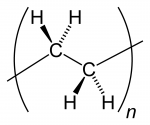
The C=C double bond normally part of an alkene is transformed into a C-C single bond in polymerization. Here is a space filling model of a polyethylene chain:

HDPE is defined by a density of greater or equal to 0.941 g/cc. It is used to make many different products including milk jugs, containers, bags, and toys. HDPE happens to have a low degree of branching and thus stronger intermolecular forces and tensile strength. HDPE can be produced by chromium/silica catalysts, Ziegler-Natta catalysts or metallocene catalysts. Those processes are beyond the scope of this paper.
Because Tyvek® is made without chemical binders and is chemically inert, it will not leach into the groundwater in a landfill. However, it can also be recycled. DuPont assets in recycling Tyvek®, and some styles are even made with up to 25% recycled material . Because Tyvek® is made of HDPE it carries the "2" recycling symbol and can be recycled at over 70 facilities in North America. Many municipalities collect HDPE for recycling. Recycled HDPE is used to make more Tyvek®, plastic lumber for decks, picnic tables, and lawn furniture. It can also be safely incinerated. Under optimal conditions it yields water and carbon dioxide and leaves almost no residue.
All of these factors lead to successful product for DuPont, and one which continues to sell well in many business divisions. As DuPont puts it, it is “a miracle of science™”.
Sources
- Information provided by mail from DuPont by my request
- Samples Booklet
- Product Handbook
- http://msds.dupont.com/msds/pdfs/EN/PEN_09004a2f800074b7.pdf The MSDS from DuPont
- http://Tyvek.com/whatisTyvek.htm "What is Tyvek®" DuPont website
- http://www.Tyvek.com/pdf/prod_techman.pdf Official DuPont Product Handbook
- Red Textbook
- http://www.earthodyssey.com/symbols.html Recycling symbol and chemical formula diagrams
- http://en.wikipedia.org/wiki/Polymerization for chemical formula diagrams
- http://en.wikipedia.org/wiki/Polyethylene for chemical formula diagrams
- http://en.wikipedia.org/wiki/Tyvek for pictures and getting me started (no facts taken)
- US Patent 3,169,899 seemed helpful but was too dense
Outline
- DuPont
- spunbounded olefin
- water vapor passes through, but not air or liquid water
- allows "breathing"
- gets rid of condensation on houses
- like paper, film, and fabric
- can be printed on
- lightweight, strong, chemical, puncture, tear, and abrasion resistant
- used for protection of people, places and things
- list other properties
- old booklet p.4 and 5
- Commercial applications
- envelopes
- fed-ex and usps
- light-use chem suits
- resistant to what (?)
- labels in harsh places
- a/c outside
- desiccant packages
- envelopes
- medical packages
- electrical equipment
- car covers
- HomeWrap
- most famous use
- clean room suits
- low linting
- outdoor banners
- w/ uv protection
- low surface friction
- dimensionally stable up to 270 F or 132 C
- producing it
- 100% high-density polyethylene
- how that's made
- made in richmond, va and luxemborg, shenzhen, china
- randomly distributed and non directional fibers
- flash spun
- laid as a web on a moving bed
- binded w/ heat and pressure
- no chemicals or binders
- change lay down speed or bonding pressures for different thickness
- 100% high-density polyethylene
- recycling and disposal
- recycling program
- can be disposed in landfill (no chems)
- enevlopes have 30% recycled product
